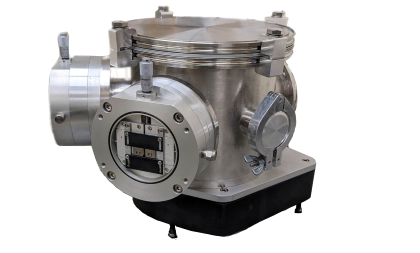
Aberration Corrected Vacuum Monochromator
The Monarch is a 200 mm focal length, vacuum compatible, aberration corrected monochromator with f/5 aperture. It has 0.1 nm fwhm spectral resolution with 1200 g/mm grating. Its precision slits are micrometer adjustable from 0.01 to 3 mm. The Monarch features a digital counter which can be convert to wavelength using the supplied software, and a sine drive providing years of accurate and reproducible wavelength positioning. The new sine drive is controlled using a new stepper driver* and a new open source Python software. The high performance masterpiece diffraction gratings provide excellent performance from the extreme ultraviolet to the UV.
Use the Monarch monochromator for any deep UV or vacuum ultraviolet application. The compact housing is easily adapted to most experiments. Microchannel plate and CCD adapters are available. Combined with one of our vacuum UV light sources it also makes a great UV tunable source.
| Optical Design | Aberration Corrected Seya-Namioka |
| Angle of Incidence | 32 degrees |
| Focal Length | 200 mm |
| f/no. | 4.5 |
| Wavelength Range | refer to grating of interest for range |
| Wavelength Accuracy | +/- 0.10 nm (with 1200 g/mm grating) |
| Wavelength Reproducibility | +/- 0.025 nm (with 1200 g/mm grating) |
| Grating Size | 40 x 45 mm (single kinematic grating holder, turret optional) |
| Slits | Continuously variable micrometer actuated width 0.01 to 3 mm. Settable height. |
| Vacuum | High vacuum 10E-6 torr standard, UHV optional |
| Focal Plane | 25 mm microchannel plate or direct detection CCD |
| Grating Groove Density (g/mm) | 2400 | 1200 | 600 | 300 |
| Spectral Resolution (nm,FWHM) | 0.05 | 0.10 | 0.2 | 0.4 |
| Dispersion (nm/mm) | 2 | 4 | 8 | 16 |
| Wavelength Range up to (nm) | 225 | 550 | 1100 | 2200 |
| Holographic Optimization: (nm) | 80 | 140 | 140 | 140 |
| 140 | 300 |
* gratings work best from 2/3 to 3/2 the optimized wavelength

The deuterium spectrum was collected with the Model 234/302 aberration corrected grating on direct detection CCD. Light source is deuterium lamp with magnesium fluoride window. For the hydrogen, helium and neon the light source is hollow cathode Model 629. The ionized HeNe scan with VUV Silicon diode shows relative response of concave aberration corrected monochromator gratings (2400 g/mm Platinum coated and 1200 g/mm Aluminum Magnesium Fluoride coated) Call 1-978-256-4512 to discuss your application today.